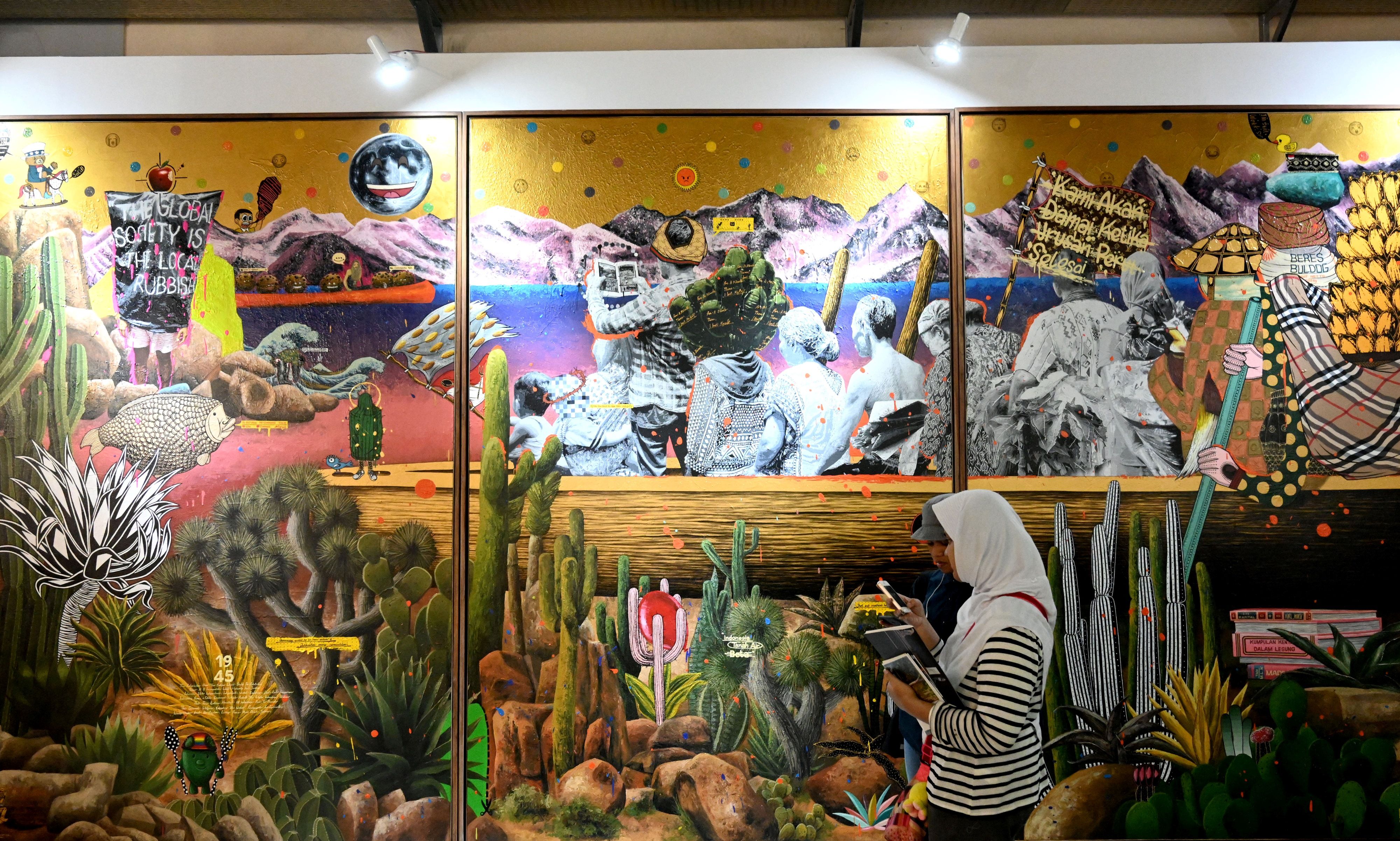
The fairground of Art Jakarta was buzzing last week as crowds of collectors and art professionals from nearby and abroad filtered into the newly refurbished Jakarta Convention Center in the heart of the Indonesian capital.
The latest edition of the event, now in its 11th year, breathed new life into the fair, which closed on Sunday. In a new and bigger venue, 39,000 visitors came out to see booths from 70 exhibitors, up from 50 last year. Of the presenters, 30 were from Indonesia while almost all of the rest—including Tokyo-based ShugoArts, Atelier Aki from Seoul, and Sullivan+Strumpf, which has locations in Sydney and Singapore—came from the region. Los Angeles-based Baik+Khneysser travelled the longest distance to participate in the fair.
But fairground chatter was also concentrated on the presence of representatives from Gagosian and Hauser & Wirth at the gala dinner of the Museum of Modern and Contemporary Art in Nusantara the night before the fair’s vernissage. Auctioneer Phillips, which hosted a charity sale for the institution, also ran a booth at the fair as an exhibitor, showing works available for private sale.
“I don’t know if [international players] come [here] because they want to find a new China,” said Tom Tandio, the fair’s director. “But they are definitely exploring new potential markets.”
A view of the fairground at Art Jakarta. Courtesy Art Jakarta.
An Economy Rich in Potential
Tandio’s positive outlook hinges on more than just wishful thinking. Auction houses such as Sotheby’s and Christie’s have been cultivating their client bases in Southeast Asia, while the China Guardian auction house in Hong Kong said spending from Southeast Asian collectors rose sixfold between 2012 and 2018.
Statistically, Indonesia boasts great untapped potential. The country has a population of more than 264 million, making it the world’s fourth-biggest nation. The population is also largely young, with a median age of 28.6. And although there has been political unrest since its independence in 1945, democracy looks to be setting roots.
But the country’s economic situation is especially noteworthy. The World Bank estimated that Indonesia would have a GDP growth of 5.1 per cent in 2019 and 5.2 per cent in 2020. Accounting firm PricewaterhouseCoopers predicts it will become the world’s fourth-largest economy by 2050.
“The growing economy [in Indonesia] means that there are more young professionals who have higher disposable income,” Tandio said. “More companies are also utilising art as a platform to have a dialogue with audiences.”
All this stands in contrast to the situation in China, where the economy is retracting, democratic institutions are nowhere present, and an escalating trade war with the US haunts the landscape.
As one Hong Kong-based gallerist put, “people are looking for a new China.”
A view of the fairground at Art Jakarta. Courtesy Art Jakarta.
A Look at the Scene
Among the familiar faces at Art Jakarta were those of Nicole Berry, executive director of the Armory Show; June Yap, curatorial director of the Singapore Art Museum; Mami Kataoka, chief curator of the Mori Art Museum; and Pauline J. Yao, lead curator of M+ in Hong Kong. Taiwanese collector Rudy Tseng and Belgian collector Alain Servais also attended.
Servais spent a week in the country, visiting not only the fair, but also artists’ studios in Yogyakarta. “It’s an immensely complex country, but understanding it helps me enormously in understanding the art,” he said. “Indonesia is a sleeping giant, with a massive economy and a very young public. Art is an extension of society, not a luxury object. I feel that Indonesia is finding its identity, figuring out how to position itself. But there will be very good art coming from Indonesia.”
Servais, who said the best work was available for $50,000 or less, said he was considering chartering a container to bring home the 10 artworks that he acquired during the week.
Art Jakarta 2019. (Photo by GOH CHAI HIN / AFP)
As far as local collectors are concerned, Tandio said familiarity was essential. “They just don’t buy unless they are familiar with the artist,” he said. “There are not that many foreign artists being shown in Jakarta, not even in the region.” He said collectors still tend to collect paintings but some have begun to take an interest in installations.
“I want this to be an Asian-centric fair,” Tandio said. And for young collectors like Nathan Gunawan, that local community and network are major draws.
“Lots of our parents did not collect,” said Gunawan, who sits on the board of young collectors of Art Jakarta. He said many young art buyers were educated in the west, and upon returning to Southeast Asia were eager to build bridges across the region.
So will Jakarta become the next art hub in the region? Despite all the optimism, Jakarta is still lacking in infrastructure. Its subway system—the only one in Indonesia—only opened in March. On top of that, imported art is also subject to a 17 percent tax, though Art Jakarta made arrangements with the local government that mandated payment only if an artwork was sold.
Regardless, the hub idea doesn’t appeal to Tandio. “I’m focused on creating a unique fair that can attract people from overseas to come and visit.”